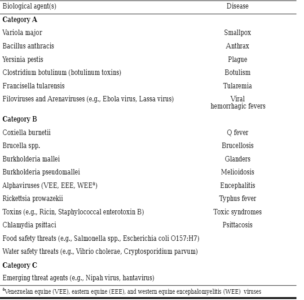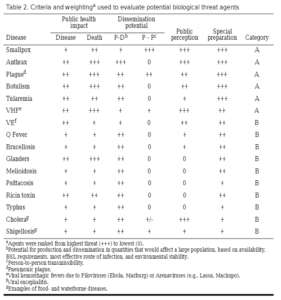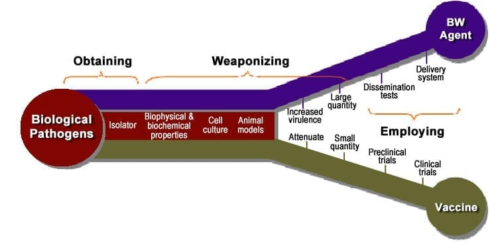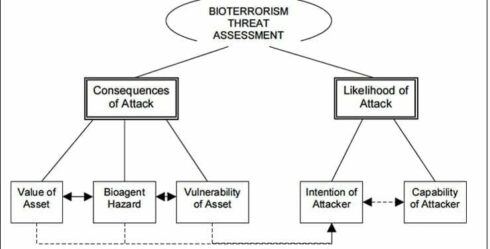DEAR FRIENDS. IF YOU LIKE THIS TYPE OF CONTENT, SUPPORT SOUTHFRONT WORK :
MONERO (XMR): 49HqitRzdnhYjgTEAhgGpCfsjdTeMbUTU6cyR4JV1R7k2Eej9rGT8JpFiYDa4tZM6RZiFrHmMzgSrhHEqpDYKBe5B2ufNsL
BITCOIN (BTC): bc1qv7k70u2zynvem59u88ctdlaw7hc735d8xep9rq
BITCOIN CASH (BCH): qzjv8hrdvz6edu4gkzpnd4w6jc7zf296g5e9kkq4lx
PAYPAL, WESTERN UNION etc: write to info@southfront.org , southfront@list.ru
Biological weapons are the subject of explicit discussions in the expert community, as this is an area shrouded in many myths. Despite the fact of many years of research, there is still no accurate information on what level various countries have reached in the field of biological weapons development. The pandemic of a new coronavirus infection has clearly demonstrated what damage a biological agent can cause on a global scale. States have begun to rethink their strategies of biological protection. With numerous studies launched in the field of biosecurity, a revival of the development of biological weapons is expected, which opens up a new potential for hybrid warfare.
Biological agents
The list of biological agents that pose a danger in case of their implementation within a biological attack includes about 40 names (viruses, bacteria, rickettsia’s, micromycetes and biological toxins). Bioagents are divided into categories (A, B, C) depending on the degree of threat they pose to the civilian population. The indicators for the study were based on morbidity and mortality rates from these infections, the possibility of transmission from one carrier to another, the availability of treatment and prevention tools.
Category A biological agents are the biggest threat to the civilian population. The developed measures to counter a biological attack are focused specifically on this category of bioagents. Their use can lead to mass casualties and even endanger the existence of individual States.
Common microorganisms can be used as a means of bioterrorist attack: colon bacillus, salmonella, influenza viruses, etc. Natural outbreaks of infections caused by these microorganisms demonstrate the danger of large-scale occurrences of these outbreaks and the complexity of their control.
Genetically modified, hybrid microorganisms pose a significant threat. The use of various molecular genetic technologies significantly complicates the counteraction to these biological agents. This is how cases of human and animal diseases were described, clinically defined as anthrax, but caused by a strain of the bacterium Bacilius cereus. It is likely that such a microorganism was a result of genetic engineering manipulations.
The most common viral infections are diseases such as smallpox, hemorrhagic fevers of Marburg, Ebola, Lassa, etc.
The greatest effect of using biological weapons is achieved by the aerosol method. When using this method, even people who are in unpressurized structures, vehicles, and equipment are exposed to infection. Protecting the body from the aerosol turned out to be a difficult task due to the lack of effective natural barriers in the body. Military experts point out that the most effective use of biological aerosol should be in the autumn-winter season. The use of biological weapons through water supply systems, food, etc. is not excluded.
The following equipment may be used for the proliferation of biological weapons:
- artillery shells and mines, aerial bombs and aerosol generators, long-range and short-range missiles, as well as any unmanned means of attack carrying biological weapons;
- aerial bombs or special containers filled with infected arthropods;
- a variety of ground vehicles and equipment for air contamination;
- special equipment and various devices for sabotage contamination of air, indoor water, food, as well as for the spread of infected rodents and arthropods.
The use of mosquitoes, flies, fleas, ticks, and lice artificially infected with bacteria and viruses seems to be the most effective option for using biological weapons, as these carriers can retain the ability to transmit the pathogen to people virtually throughout their lives. And their life span can range from several days or weeks (flies, mosquitoes, lice) to several years (ticks, fleas)
Legal aspects of the prohibition of biological weapons
The Protocol on the Prohibition of the Use of Asphyxiating, Poisonous or Other Similar Gases and Bacteriological Agents in War was adopted in Geneva on July 7, 1925. It was ratified by 65 States, which declared an absolute ban on the use of bacteriological weapons in military conflicts. However, the protocol did not specify mechanisms for monitoring, measures of State responsibility and procedures in case of its violation. This greatly reduces its value.
The Convention on the Prohibition of the Development, Production and Stockpiling of Bacteriological (Biological) and Toxin Weapons and on Their Destruction (BTWC) was signed on April 10, 1972. BTWC affects 1) microbiological and other biological agents or toxins that are not intended for preventive, protective or other peaceful purposes; 2) weapons, equipment or means of delivery intended for the use of such agents or toxins for hostile purposes and in armed conflicts. Currently, 163 States are parties to the Convention, but the lack of a verification mechanism has limited the effectiveness of the implementation of its provisions.
Within the framework of the BTWC conferences, expert meetings continue on the following topics:
- prevention of the use of scientific and technological achievements in biological sciences for hostile purposes;
- improving the safety of work with pathogens and toxins; improving national measures taken in the implementation of the BTWC;
- regional cooperation in the implementation of the Convention;
- international cooperation in the field of biotechnology;
- providing assistance in the case of the alleged use of bioweapons.
The Convention does not specify the legal consequences for States violating the Convention. The mechanism of punishment most likely includes the mechanism of the UN Security Council. This means that the permanent members of the UN Security Council can circumvent the Conventions without consequences for themselves. There have been no precedents for punishing violations of the Convention yet.
This Convention has a number of significant drawbacks:
- the Convention applies only to its participants. The responsibility of the other States is excluded;
- unrecognized States remain outside the Convention;
- the convention does not list the types of biological agents;
- States can legally develop, accumulate, acquire, preserve equipment and means of delivery for defensive purposes;
- inefficient control method.
UN Security Council Resolution 1540 was signed on April 28, 2004. The resolution establishes obligations for UN Member States to develop and ensure appropriate legal and regulatory measures against the proliferation of chemical, biological, radiological and nuclear weapons and their means of delivery. The need to prevent the proliferation of weapons of mass destruction among non-State actors is particularly highlighted.
The weakest point in the international legal mechanism for combating use of biological weapon is the institute for preventing the proliferation of biological weapons. There is no specialized international organization for monitoring the implementation of the BTWC, there is no international convention on combating biological terrorism.
Development of bioweapons by States
The targeted use of biological weapons began with the First World War by Germany and Japan. These countries used anthrax strains. Many German experiments in this area failed, and with the signing of the Geneva Protocol of 1925, the development of biological weapons became more difficult. Nevertheless, during the Second World War, Japan created a whole squad 731 for experiments with biological weapons. It is reliably known that this detachment purposefully infected the Chinese population with bubonic plague. Germany was engaged in the spread of malaria vectors in the Pontic marshes.
The USSR and the USA were also engaged in the development of bioweapons. There are no obvious facts of the USSR developing biological weapons, but there is information that makes it clear that attempts to develop such weapons have been made. Secret institutions were established in Leningrad, Sverdlovsk, Suzdal. In 1934, it was reported about the readiness of weapons codenamed “substance 49” based on anthrax. It is known that 64 people died as a result of the leakage of spores of the causative agent of some disease in the area of bacteriological laboratory No. 19. After the collapse of the USSR, all development of biological weapons was curtailed.
According to experts, the United States currently has about 400 institutions that carry out secret programs in the field of biological research. In 2001, the United States refused to sign an addendum to this convention regulating mutual control mechanisms. Moreover, according to the U.S. Federal Act “Uniting and Strengthening American by Providing Appropriate Tools Required to Intercept and Obstruct Terrorism Act” (the “Patriot Act”), research in the field of bacteriological (biological) weapons is allowed with the authorization of the U.S. government. At the same time, participants in such research are not criminally liable for developing such weapons. Therefore, there is no reliable information about what they do in these laboratories. There is no public reporting on the activities of these centers.
The specific fields of their researches may be guessed following some accidents. In 2014, under strange circumstances, employees of a biological laboratory in Atlanta were infected with anthrax bacteria. Another accident took place in the laboratory at Fort Detrick. This laboratory is a military base where materials about the bacteriological weapons of the Japanese “Detachment 731” are stored. In 2019, cases of pneumonia of unknown genesis were recorded in two nursing homes near this laboratory. Later, an outbreak of pneumonia in the whole state of Maryland was mentioned. After a significant increase in the number of respiratory diseases of unexplained origin, the closure of the laboratory at Fort Detrick was announced.

While the U.S. Department of Defense maintains that its massive biological research programs are meant to counter and defend against new biological weapons being developed, they are in fact developing bio-weapons in the process.
In addition to domestic laboratories, the United States actively involves foreign laboratories in its researches in the field of biological weapons. These US bio-laboratories are funded by the Defense Threat Reduction Agency (DTRA) under a $ 2.1 billion military program – Cooperative Biological Engagement Program (CBEP), and are located in former Soviet Union countries such as Georgia and Ukraine, the Middle East, South East Asia and Africa. Usually, these laboratories are heavily protected. Civilian observers and journalists are allowed only into civilian facilities. Only US citizens with the third degree of biosecurity can enter the completely closed premises of the center. At the same time, the text of the agreement on the opening of the biological center also remains secret. As part of the activities of such laboratories, it is reported about the collection of the genome of the local population and the development of tools that affect only certain ethnic groups.
In 2018, former Georgian Security Minister Igor Giorgadze appealed to US President Donald Trump to investigate the activities of a biological laboratory in Georgia. According to Giorgadze’s statement, experiments on people are being conducted at the Richard Lugar Public Health Research Center. He also pointed out that local staff do not have the right to get acquainted with US documentation and do not have access to closed parts of laboratories. A person from the military or intelligence services is appointed director of the laboratory. All American personnel have diplomatic immunity. Transportation of any biomaterials for laboratories is carried out without declaration and control by local authorities. It is likely that such way of cooperation was established in all foreign laboratories. Thus, the documents indicate that in December 2015, 30 people who were treated at the center for hepatitis C died. 24 patients died in one day. Materials on the results of the conducted research on the impact of an unknown drug on Georgian citizens, which resulted in the death of more than 160 people were made public. There are reasons to believe that the R. Lugar center has conducted tests of a highly toxic chemical preparation or biological agent with high lethality. It is the center that experts call a potential center for the development of biological weapons. Contractors for a number of studies were US military companies.
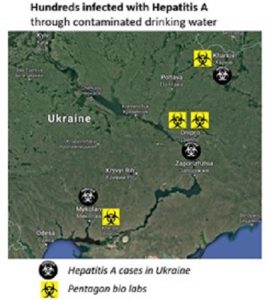
Hepatitis A has caused an unexplained epidemic in South Eastern Ukraine, where most of the Pentagon’s biolabs are located. In 2011, 33 people were infected with cholera in the Ukraine. The epidemic is repeated in 2014, when more than 800 Ukrainians were diagnosed with the dangerous disease. In 2015 in Nikolaev more than 100 new cases of cholera infections were registered.
The United States has deployed 11 biological laboratories in Ukraine alone. With the launch of these laboratories, Ukraine began to experience outbreaks of diseases that were already considered defeated. According to WHO data, in 2018 Ukraine became the leader in Europe in the incidence of measles. Such cases were also observed in Georgia.
Biological centers abroad solve a number of important tasks:
- work with especially dangerous strains outside their own territory without a threat to their citizens;
- the study of microorganisms focused on the defeat of a specific human genotype.
Russia has repeatedly accused these laboratories of artificial outbreaks of infection in border areas. The activities of the Pentagon aimed to deploy its biomedical laboratories in different parts of the world, including in the immediate vicinity of the Russian borders, cause growing concern in the Russian Federation, considering that the US authorities are making efforts to conceal the true content and direction of the projects being implemented. Taking into account the fact that the United States has not yet withdrawn its reservation to the Geneva Protocol of 1925, which prohibits the use of bacteriological weapons, the question arises quite reasonably about the true goals of such US military biological activity in the post-Soviet countries. As a response to such actions, Russia has launched the « Sanitary Shield » project. Within its framework, 36 laboratories for the study of biological agents will be created in Russia by 2030.
In its turn, China has a developed biotechnological infrastructure and technological capabilities for the development, production and use of biological weapons. China is a member of the BTWC and has consistently stated that it has never researched or produced biological weapons. The US National Center for Counterintelligence and Security (NCSC) has consistently accused China in its reports, claiming that Beijing produces virulent pathogens. According to American experts, China plans to create the world’s largest database of medical and genetic data. Based on this, China will be able to create biological weapons aimed at specific people or groups of people.
There was a lot of talk about Chinese biological weapons after the outbreak of a new coronavirus infection. With the beginning of the coronavirus pandemic, many hypotheses about its origin have appeared. There are some noteworthy ones among them. Breakthroughs in areas such as chemotherapy may contribute to the development of more advanced biological agents. There is a certain correlation between the means of treatment and the means of defeat. One sphere influences another. China has made significant progress in the development of CAR-T technology. This technology allows artificially embedding a chimeric antigen receptor into the patient’s blood cells. The COVID-19 coronavirus is also a chimeric virus, that was created using CAN-T technology.
The first outbreak of coronavirus occurred in the area of the Wuhan BSL-4 biological laboratory. However, there is a rather unknown fact the 2019-nCoV coronavirus was first detected in 2012. Later, samples of this coronavirus were acquired by the Canadian National Microbiology Laboratory in Winnipeg. A group of Chinese virologists from this laboratory was dismissed in July 2019. They were accused of smuggling a batch of viruses into China. It cannot be ruled out that the new coronavirus infection is a biological warfare weapon that purposefully or accidentally caused a massive pandemic. This version has been widely discussed in the expert community. At the moment, this version is perceived as a hypothesis or even a conspiracy theory. However, in the absence of reliable information, such hypotheses cannot be completely denied.
Bioterrorism
In the 21st century, the expert community began discussing the phenomenon of bioterrorism – the deliberate, conscious and purposeful use of pathogenic organisms instead of explosives used in classical terrorism. Before analyzing the phenomenon of bioterrorism, it is necessary to understand that states set the task of developing bioweapons for its systemic use. Talking about bioterrorism, those who want to commit a terrorist attack in order to intimidate the population do not need means of production or sophisticated technologies. For terrorists, the very fact of access to any biological agents is important.
Biological weapons by their characteristics are ideal for carrying out a terrorist attack. This is facilitated by the modern level of development of scientific and information technologies that allow attackers to find information from open sources about the methodology, features of the manufacture of biological weapons. As in the case of traditional acts of terrorism, various factors can serve as reasons for committing bioterrorism: from intentions to influence the socio-political situation to establishing one’s leadership in the country. Acts of bioterrorism can be carried out both by individuals and by an entire terrorist organizations.
Bioterrorism uses specially selected or artificially created microorganisms – biological agents. Once in the human body in negligible quantities, pathogenic microbes and their toxic products cause extremely severe infectious diseases. The main danger of using biological weapons is that it is almost impossible to prevent the uncontrolled spread of pathogens with high virulence and contagiosity.
For example, as a result of a terrorist attack by sending letters with anthrax powder in envelopes in 2001, the work of the Federal Postal Service was paralyzed for 2 months in the United States and 5 people died. Huge sums were spent on the creation of diagnostic laboratories, antibiotic therapy for 32 thousand people. According to experts, if an attacker had used other easily propagated biological agents instead of anthrax pathogens, the terrorist act could have escalated into a large-scale epidemic. Analysis of the genome of the strain used in the terrorist attack showed that anthrax spores in envelopes could have been obtained for at least two years. The quality of the drug indicated that it was obtained with the help of technological equipment possessed by large research laboratories.
The following advantages over classical terrorism may contribute to the growth of acts of bioterrorism:
- the duration of the impact of bioterrorism, the spread of the epidemic over a large area,
- difficulties in identifying some biological agents,
- bioagents have an incubation period, during which time its carrier can travel long distances and cause an outbreak of an epidemic in another part of the planet,
- the use of biological weapons does not entail the destruction of infrastructure.
The growing threat of bioterrorism acts can be associated with an increase in the number of specialists in the field of biotechnology and the availability of open access to technologies for the production of biological products.
The threat of biological terrorism remains relevant due to the relative availability and cheapness of the use of pathogens. Despite this, there are a number of deterrent factors for those wishing to use biological weapons for terrorist purposes:
- the difficulty of obtaining a pathogen suitable for a terrorist attack. It is quite difficult to get a virulent culture. Strains of smallpox, polio, typhus have been practically eliminated. So, in the last known attempts to use biological weapons, groups bought vaccinated strains of viruses;
- difficulty in justifying the choice of the nosoform and the isolate of its pathogen;
- difficulty in determining and observing the conditions of a bioattack depending on the location, time, state of the atmosphere, ventilation flows of the structure, etc.;
- financial and organizational difficulties in the preparation of biological attacks;
- the difficulty of involving specialists capable of working with virus pathogens in the preparation of a bioattack. At the same time, it cannot be ruled out that terrorist groups will receive support from States, but the probability of such a step is still small.
Conclusion
States are actively considering biological weapons as one of the ways of conducting hybrid wars in the future. When developing means of protection against such weapons, offensive variants of biological weapons are also being actively studied. In the era of nuclear deterrence, weakening a potential enemy with the help of biological weapons is the most likely option for a future war. The modern legal framework practically does not restrict the activities of States in this area, because biological weapons are actively being developed under the guise of protective or peaceful scientific research.
At the moment, it is impossible to draw a line between peaceful research and the development of biological weapons. The non-use of biological agents for offensive purposes remains only on the conscience of States and is not limited by any specific mechanisms. Research in the field of creating biological weapons will continue on the part of a number of States, primarily as a way of deterring and intimidating rivals. In general, natural outbreaks of viruses currently pose an even greater danger to humanity. Terrorist acts with the use of biological weapons are unlikely, but not excluded in the future. It is important to prepare in advance for the threat of biological terrorism through the training of specialists in these fields, continuous cooperation through international organizations.
MORE ON THE TOPIC:
- Status And DEvelopment Of US Military Biological Projects
- The Geopolitical Deployment Of Biological Weapons – Part II
- Pro-ISIS Propaganda Suggests To Use Improvised Biological Weapons For Terrorist Attacks
- At Least 73 Georgians Likely Killed By US Toxin Or Bioweapon Disguised As Drug Research: Russian Military







